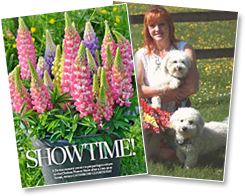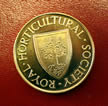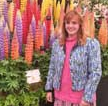(Cyperaceae) Sedge. Vast genus of 1,500 or more species of deciduous, evergreen or herbaceous tuft-forming, perennial sedge. Found in temperate and arctic zones as well as high altitudes in tropical regions. Most species occur in bog, moorland, or damp woodland or by water. Sedges are mainly cultivated for their variegated or colourful foliage. Narrow leaves often colouring in autumn, triangular, solid and without nodes. Cut back dead foliage on herbaceous ones when dormant. Small flowers arranged in panicles, racemes or spikes. Will withstand drought once established. Most originate from New Zealand and tropical areas.
(Athyriaceae/Dryopteridaceae/Woodsiaceae) Genus of 180 species of deciduous terrestrial ferns found mainly in moist woodland or forest in temperate and tropical regions of the world. Good for shade. Prefer acid soils. Remove fading fronds regularly.
(Dryopteridaceae) Genus of about 200 species of terrestrial ferns found mainly in temperate regions of the N. hemisphere where they grow in woodland, by streams or lakes and among mountain rocks. Most are deciduous, some are semi-evergreen in mild winters. Pinnate to 4-pinnate fronds form shuttlecock-like crowns. Foliage looks effective with herbaceous plants and shrubs. Remove fading fronds regularly. D. affinis will tolerate more sun and wind that other species. Prefer acid soils
Osmundaceae. Genus about 12 species of deciduous, terrestrial ferns found in damp places and watersides in all continents except Australasia. Broadly lance-shaped fronds arise from rhizomes turning yellow gold in autumn. Most require shade and wet conditions. Remove fading fronds regularly. Hardy. Keep crowns out of water. Good for woodland or as marginals. Will grow in full sun if moist. Prefer acid soils
(Polypodiaceae). Polypody. Genus of about 75 species of mostly evergreen ferns mainly from tropical regions of the USA, Central America and South America but also from temperate and other tropical regions. Found growing on trees, rocks, walls or well drained banks and sand dunes. They are cultivated for their sculptural fronds which are usually lance-shaped, simple to pinnatifid or pinnate. Young herringbone like fronds develop early summer. The creeping rhizomes are covered with copper coloured scales.
They will put up with drier conditions than most ferns such as dry shade. Evergreen, easy and tough - looking best in winter. Excellent groundcover. Some will grown on rock gardens others in mixed borders or banks. You will see it growing out of the trunks of old trees in a wood.
(Dryopteridaceae). Holly Fern, Shield Fern. Genus of nearly 200 species of usually evergreen, rhizomatous terrestrial ferns found in a range of habitats from alpine cliffs to tropical forests worldwide. Like damp, humus rich soil but lime tolerant and will take some sun or dry shade. Architectural specimens with 'shuttlecock' crowns. Setiferum refers to the seta or bristle, which every pinnule ends in. Pinnae (leaves) have characteristic 'mitten' shape and are holly-like. Remove faded fronds regularly. Good on raised beds on a corner or rockeries.
Prefer alkaline (lime) soils in full or semi shade best.




 Our Story Information about our nurseries
Our Story Information about our nurseries
 Chelsea - Gold Winner! We won gold at Chelsea flower show!
Chelsea - Gold Winner! We won gold at Chelsea flower show!
 Our Awarding Lupins Our award winning Lupins varieties
Our Awarding Lupins Our award winning Lupins varieties